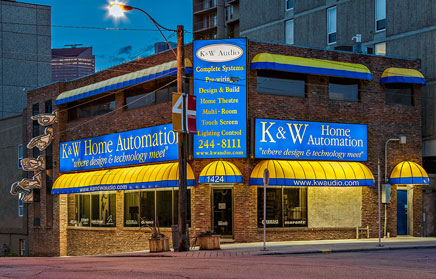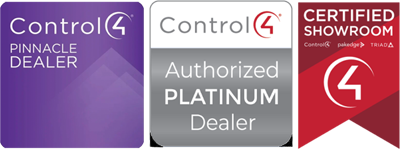Home Theater Projector Screens
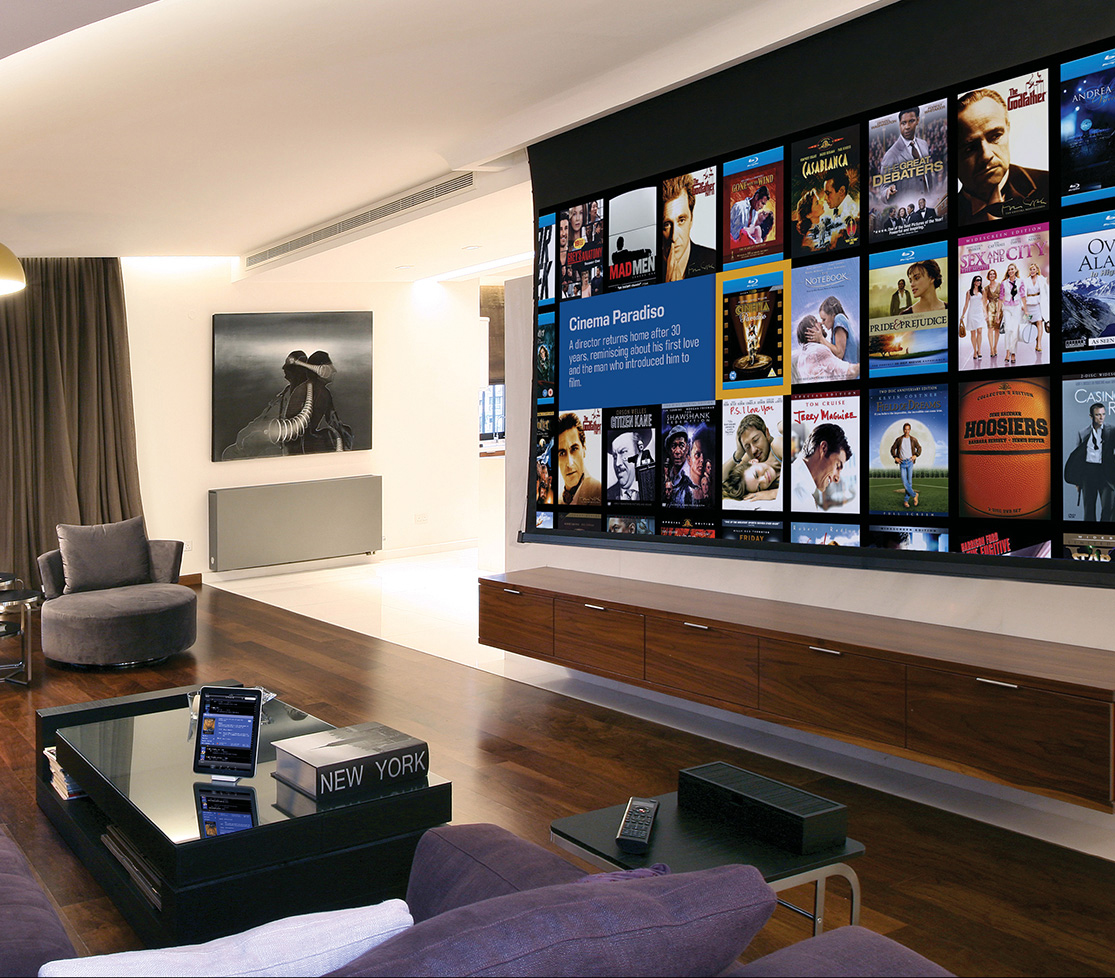
What is a really big screen? Well a 65” LCD on the wall is big, but for a really big screen experience there is a better way to go….
A real Home Theater has a projector. Thus, it must have a projector screen – preferably a really BIG projection screen. That’s the whole point, otherwise it’s a media room. Here at K&W Audio we have done projector/ screen combinations since the early 80’s. As such, we offer every major choice of screen manufacturer. Consider a variety of elements when specifying the correct screen for your home projection application. Furthermore, some of those options you may not even be aware of. Perhaps your choice of screen may not be as straight forward as one might think at first blush. Therefore, exploring the new possibilities can only open up better fits and possibilities in your application. So, let’s explore.
Projector Screen Material
The screen material is the most important element in the projection chain. Full stop. Think about it. If the screen isn’t there, you see nothing. If it’s green and rough, so is your image. When you go to a quality movie house, you watch a very high tech material specifically designed to do the job. This material is usually by Stewart Filmscreen of California – FYI.
Choose the right screen material based on size, shape, and viewing angle. Consider needed reflectivity (or Gain), projection type, room light levels and light intensity. Most importantly, determine your budget. These factors help us quickly determine the right screen material for you. Once that’s done, it’s on to the fun of deciding how the screen will be mounted in the space. Let’s move on to look at those options.
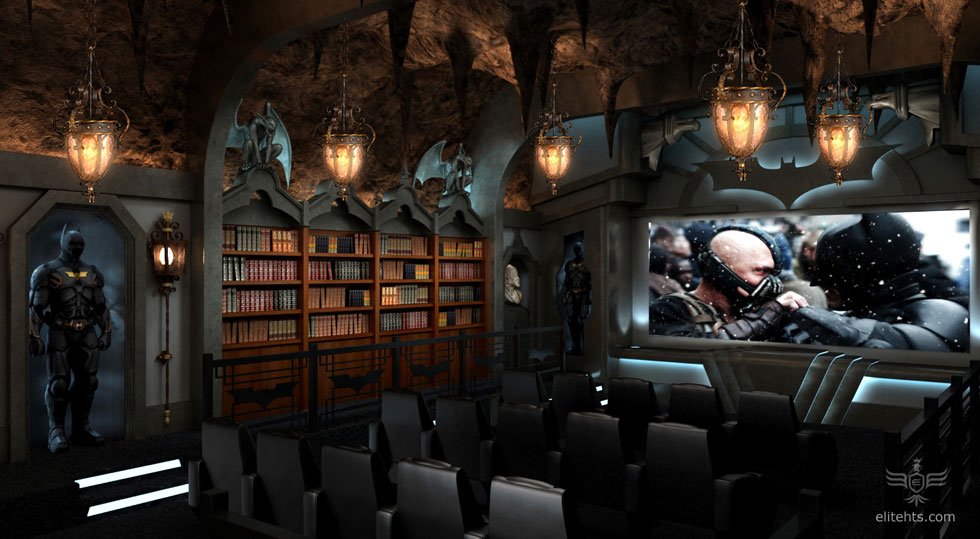
Fixed Mount Screens
The fixed projector screen is where we start. The most popular option is the classic screen mounted on the wall. It can look impressive. Firstly, one of the most important areas to consider, is the screen’s aspect ratio. Today, the most popular aspect ratio is 1.78:1, more popularly known as 16×9. That’s the same shape as all the current LCD TV set screens on the market.
Many movies and HDTV will fit this size perfectly. However, a strong philosophy favors the 2.35:1 Cinescope shape for the modern Home Theater. After all, today’s big budget and more ‘Artsy’ movies are usually shot in that more letterbox-ish ratio. Because of this, dedicated home theater screens today have migrated toward this widescreen format. Unfortunately, we still don’t always eliminate the dreaded black bars 1:78 so often still presents. Thankfully, they are only on both sides of the image now. Additionally, they happen only rarely when we watch a 1:78 ratio movie or TV show.
Motorized Masking
If you want to address those side black bars, you can choose additional motorized masking for your screen. This masking frames movies in all ratios by descending on both sides of the screen. This includes your HDTV content at a 1:78 aspect. There is obviously an extra cost to doing that though. In that case, these “constant vertical height” curved electric screens eliminate all horizontal black bars. So, when the time comes to watch a movie in any format, the screen re-masks to display only the proper aspect ratio of visible screen area.
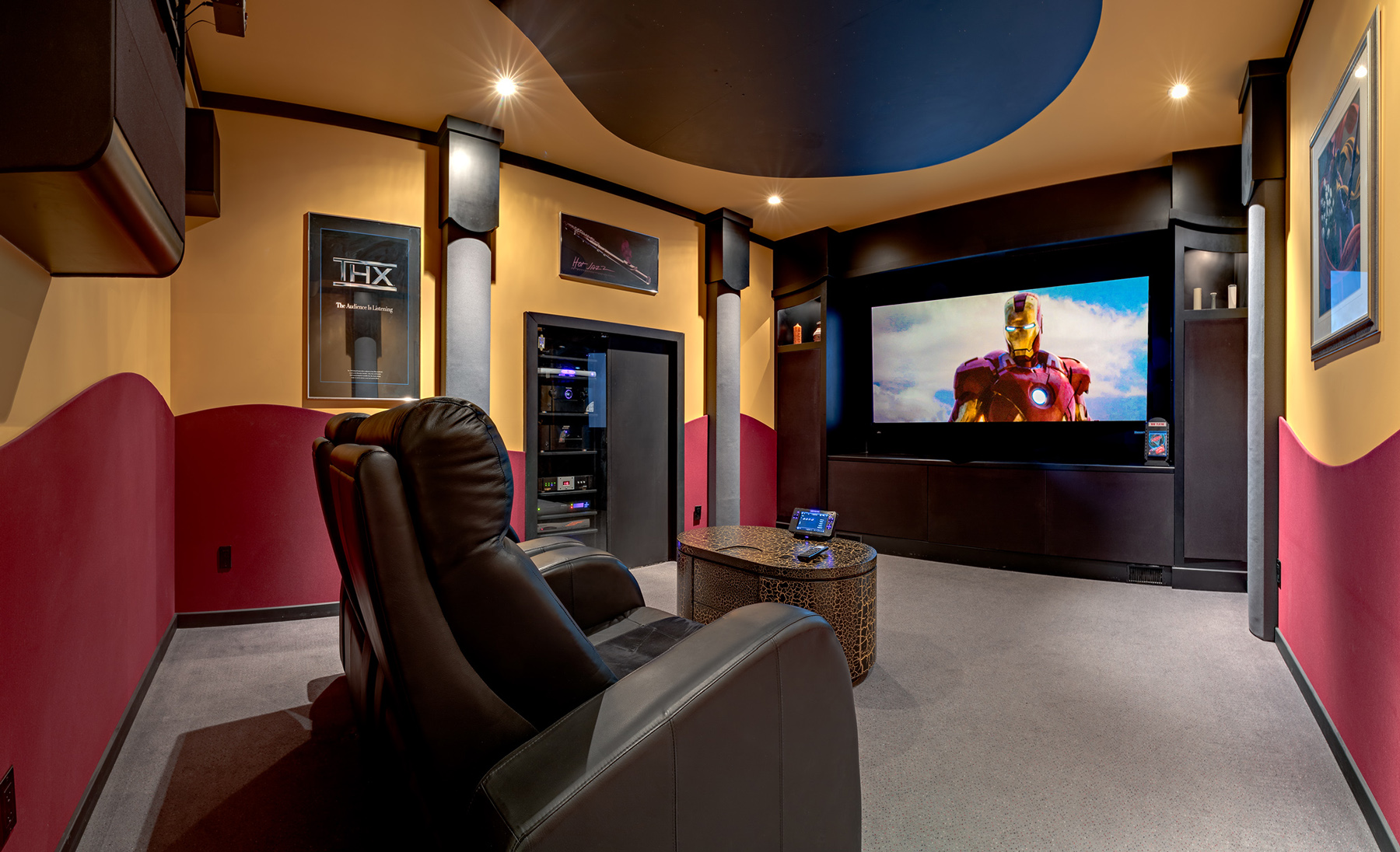
Curved & Masking Screens
Curved screens and the accompanying fascia are very popular, and they can be self-masking too. The concave shape of the Cinecurve screen focuses light back to the seating area. Consequently, this makes the projected image appear even brighter. It limits the amount of light reflected to the theater side walls. Thus, creating an image that really pops with color and black level.
Typically, pairing an anamorphic lens assembly with a leading-edge projector upgrades the image to 4K resolution standards. It gives this widescreen option the state of the art in size, shape and resolution. If you are considering this option – even in the future, it is best considered at the design phase. Specifically, the required projection throw distance can change a bit to accommodate this extra lens option. If you want current state of the art, these motorized Cinecurve screens, with a 4K projector utilizing an anamorphic lens are the answer.
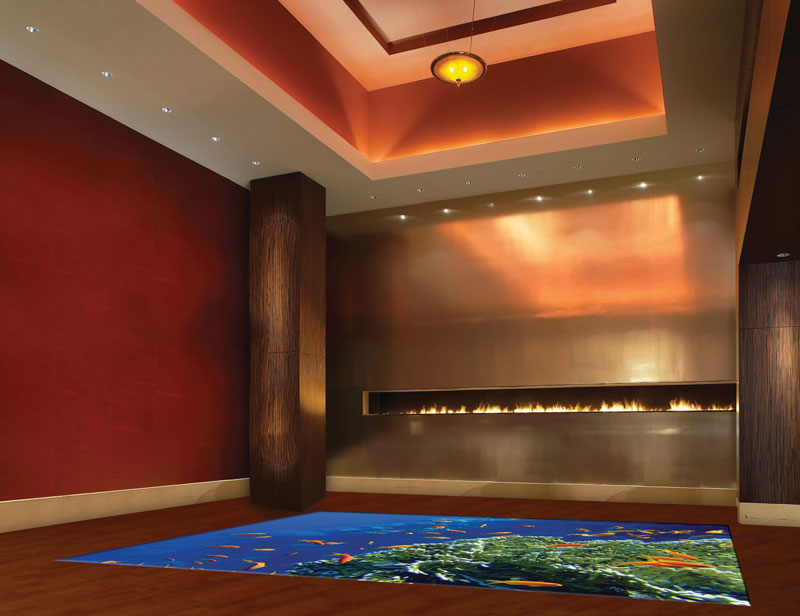
Rear Projection & Starglas
Rear projection is another approach often overlooked, but with several big advantages. If you are building a home theater in the basement, and have an adjacent utility room, you are a potential candidate. Mounting your projector in the utility room and hanging a rear projection screen on an aperture wall can result in a brighter image with less ambient light interference than front projection.
So, walk out basements without perfect lighting control can still have a great Theater experience. Plus, with the projector completely out of the theater space, there is absolutely no projection noise, and there is no loss of head room to a ceiling mounted projector in the space.
Even better, no one can stand up and cast a shadow in front of the projector when the movie is playing! You need to spend some time planning here again, and we can provide as build drawings to scale for any size or configuration.
Starglas from Stewart Filmscreen
It needs to be noted that Stewart Filmscreen has come up with a rather inspired surface in this category, called Starglas. Starglas uses a glass surface for rear-projection instead of opaque screen material. What makes Stewart Filmscreen Starglas unique is the fact that, when used properly, you can view huge images in full lighting conditions, making a Starglas installation more like massive plasma or an LCD then a front-projection system. It’s like viewing the film on the world’s largest TV, and looks like a sheet of glass.
Starglas Outdoors
Going one step further, you can even use Starglas outdoors for a unique home theater experience by your pool, deck or barbecue. Don’t worry about damaging or marring your Starglas surface either. Its tempered glass is rated for commercial applications. It can be cleaned via hose or perhaps a little more prudently, with Windex.
Starglas can manufacture projector screens up to 204 inches large. As you can imagine, the performance and cool factor of Stewart Filmscreen Starglas makes it the choice in some very innovative designs. Suspended it on steel cables – effectively floating in space – on a table top or even in a floor. And, provided you can mount a projector properly, it creates a very cool James Bond-like effect.
Cost & Benefits of Starglas
Starglas runs about $300 per square foot, which is quite a bargain, considering the benefits it provides over a huge plasma or LCD display, which retail for easily six figures. There is a caveat regarding Starglas though. Just like any other screen choice, Starglas requires our professional design expertise for the right result. While not as simple as the picture-hanging technique, often used for flat-panel displays these days, the performance and cool factor of Starglas can blow all other display options out of the water. Here is an example.
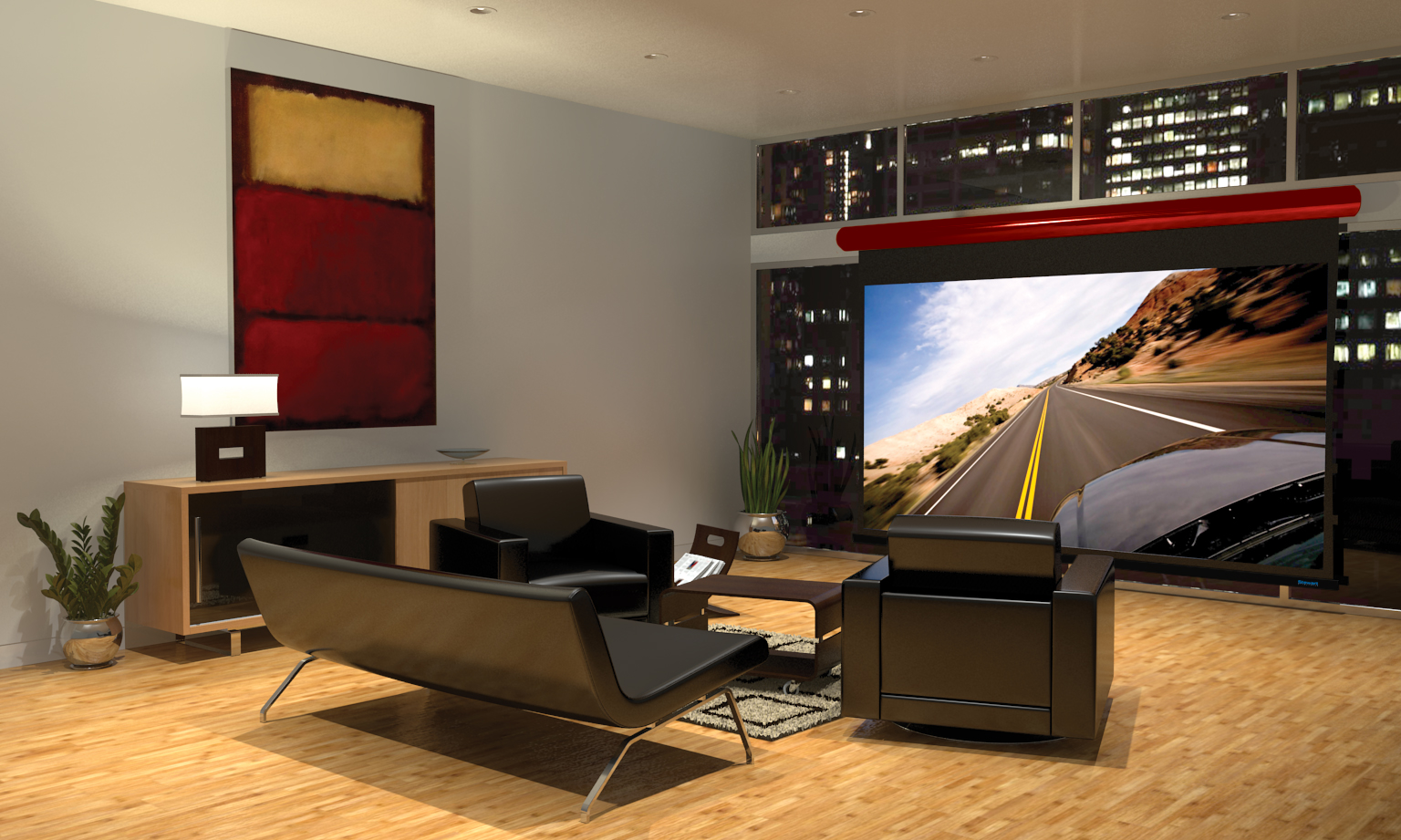
Cabaret Projector Screens
Power driven drop down projection screens are another popular choice. Today people don’t want to end up with a black can housing their rolled-up screen in their home – looking like a high school gymnasium. There are options. Completely hidden screens that descend from a trap door built into the ceiling are one option. Alternatively, new housings stylishly designed and custom colored to the room (or contrasting for that hi-tech look) are another great choice. This stylish offering allows for the creation of home theaters within dens, recreation rooms, or any other home living spaces, and they can be hidden away at a moment’s notice.
Valances & LED Lighting
With Stewart Filmscreen’s Cabaret the video screen is housed in a stylish aluminum valance, available in various finishes. It can be customized to taste with various colors, fabrics & even accented with LED lighting that shines from the top of the valance in your choice of cobalt blue, or white to further enhance the space.
The screen housing’s unique customization level turns it into a beautiful enhancement for any environment. However, it also keeps the video screen completely out of sight when not in use. Its sleek and contemporary design makes it possible to install a front projection system into any size space, with any décor and blend into the environment.
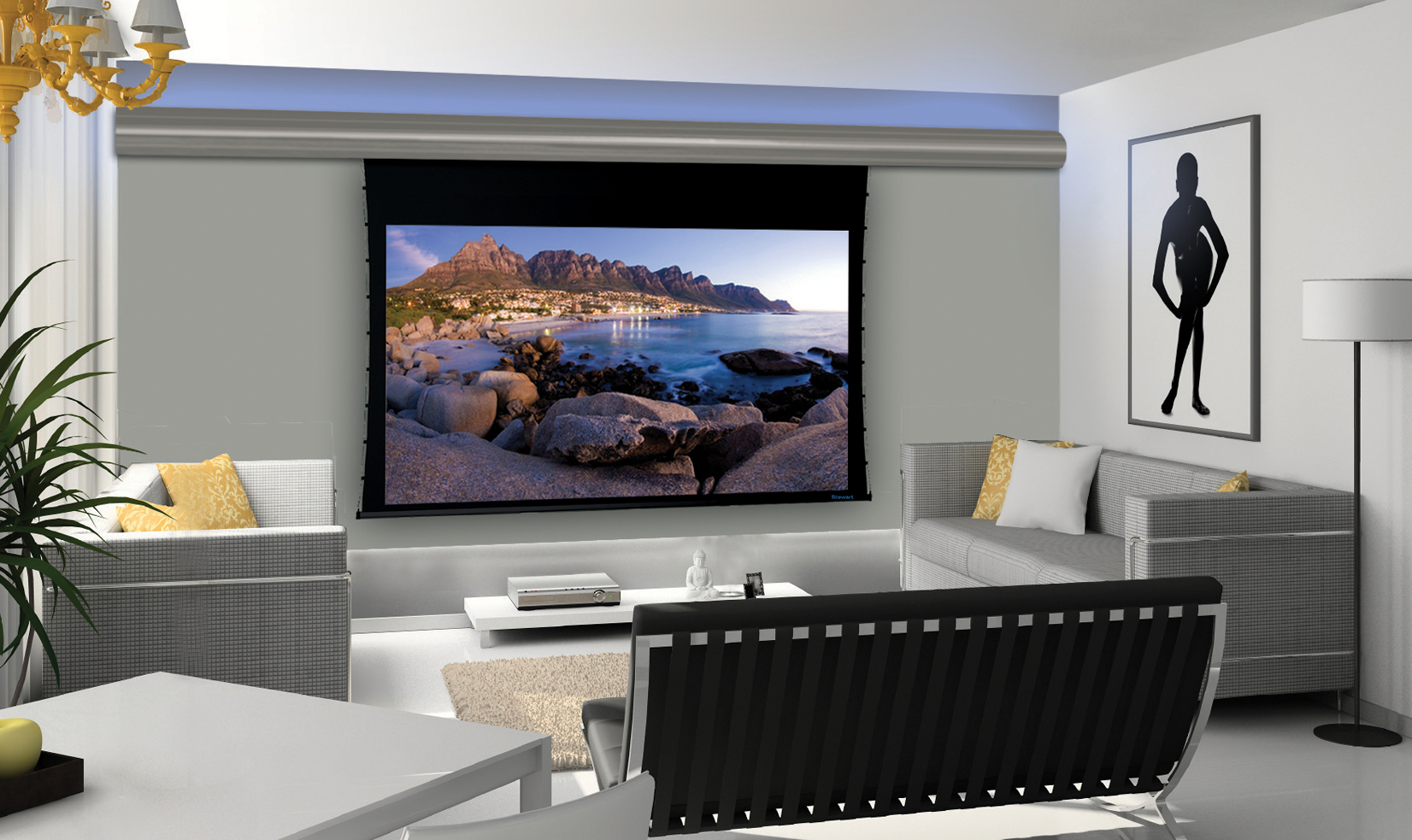
Americana Projector Screens
This housing can be as wide as 16 feet, while the screen it houses can be smaller. The screen descends from any point along its length. The designer can install the housing like a valance, allowing the screen to drop only where it looks best. The Stewart Filmscreen Cabaret can also be installed above flat panel TVs or picture frames. When the screen is lowered, it won’t touch either. This unit’s versatility allows it to feel at home within a traditional suburban living room. Or, in a sleek and contemporary loft. This drop-down screen style lets you orient room furnishings toward the view at all times.
Acoustic Transparency
Yet another area to consider when kicking around what projection screen is right for you is acoustic transparency. This allows you to mount all of your front speakers directly behind the screen. “But a screen in front of my speakers has to change the sound” you say. Well, you would be right. That’s why the good folks at Lucasfilm THX along with Stewart Filmscreen a have developed the THX perforation. Basically, teeny tiny holes in the screen, arranged in a way that doesn’t amplify pixel orientation, combined with a specifically designed equalizer you connect to your surround amplifier nets you the same or better performance than available at your favorite theater.

Yet another area to consider when kicking around what projection screen is right for you is THX acoustic transparency. You can mount all your front speakers directly behind the screen for acoustic transparency. “But a screen in front of my speakers has to change the sound” you say. Well, you would be right. That’s why the good folks at Lucasfilm THX along with Stewart Filmscreen a have developed the THX perforation. Basically teeny tiny holes in the screen, arranged in a way that doesn’t amplify pixel orientation. These combine with a specifically designed equalizer you connect to your surround amplifier. Accordingly, this nets you the same or better performance than available at your favorite theater.
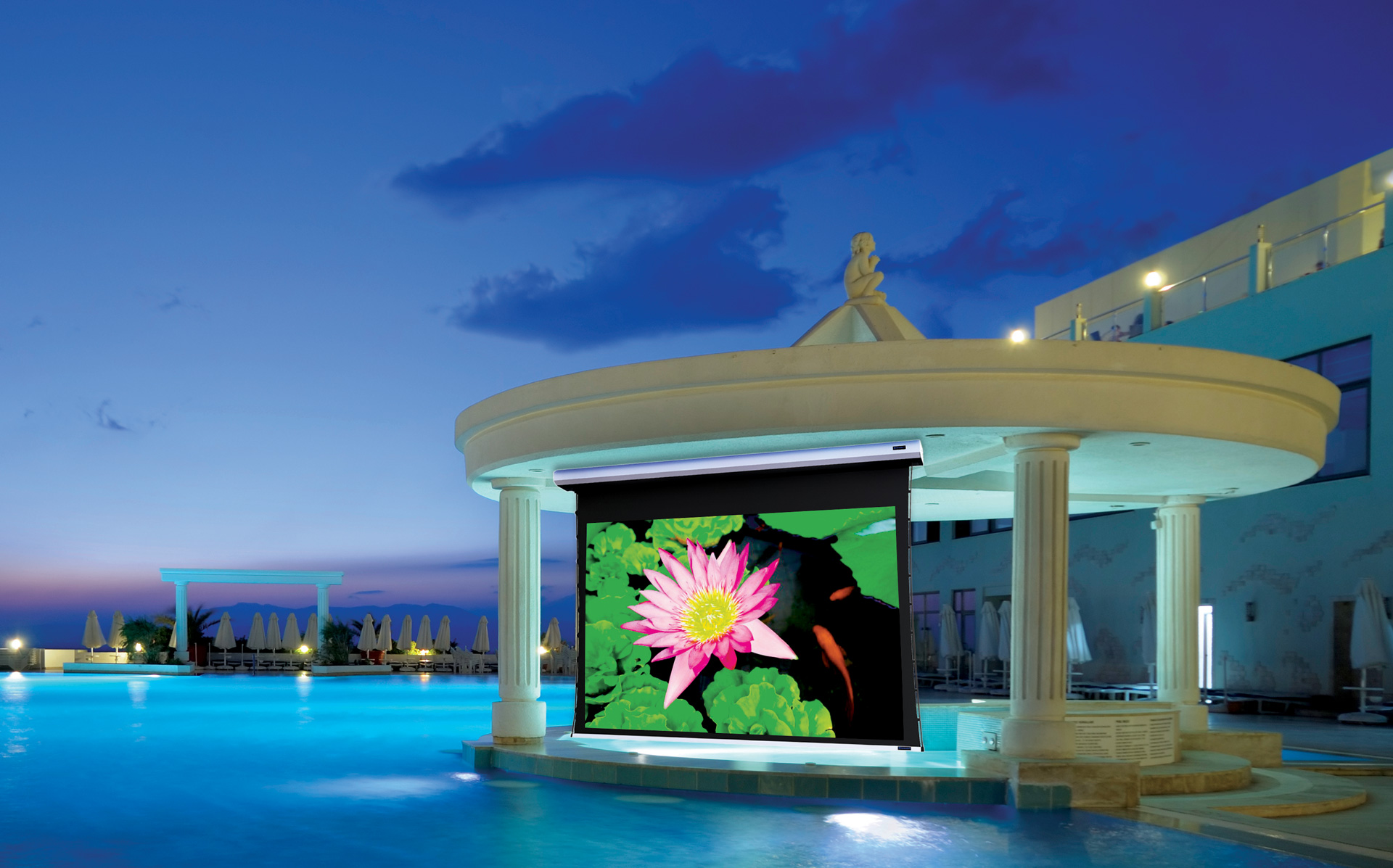
Outdoor Projector Screens
Do you love being outdoors on your spacious patio? Maybe you have an amazing view of the mountains or live right along the shore. Entertaining your friends and family outside during Superbowl Sunday. Or, perhaps watching a movie while feeling the refreshing ocean breeze in a weather-resistant video theater Oasis. This alone is a remarkable experience. Outdoor theaters create upscale outdoor living spaces.
We design electronically controlled retractable projection screens specifically for outdoor use, resistant to corrosion and other outdoor elements. They are just too cool. You know you will be the only one on the block with one!
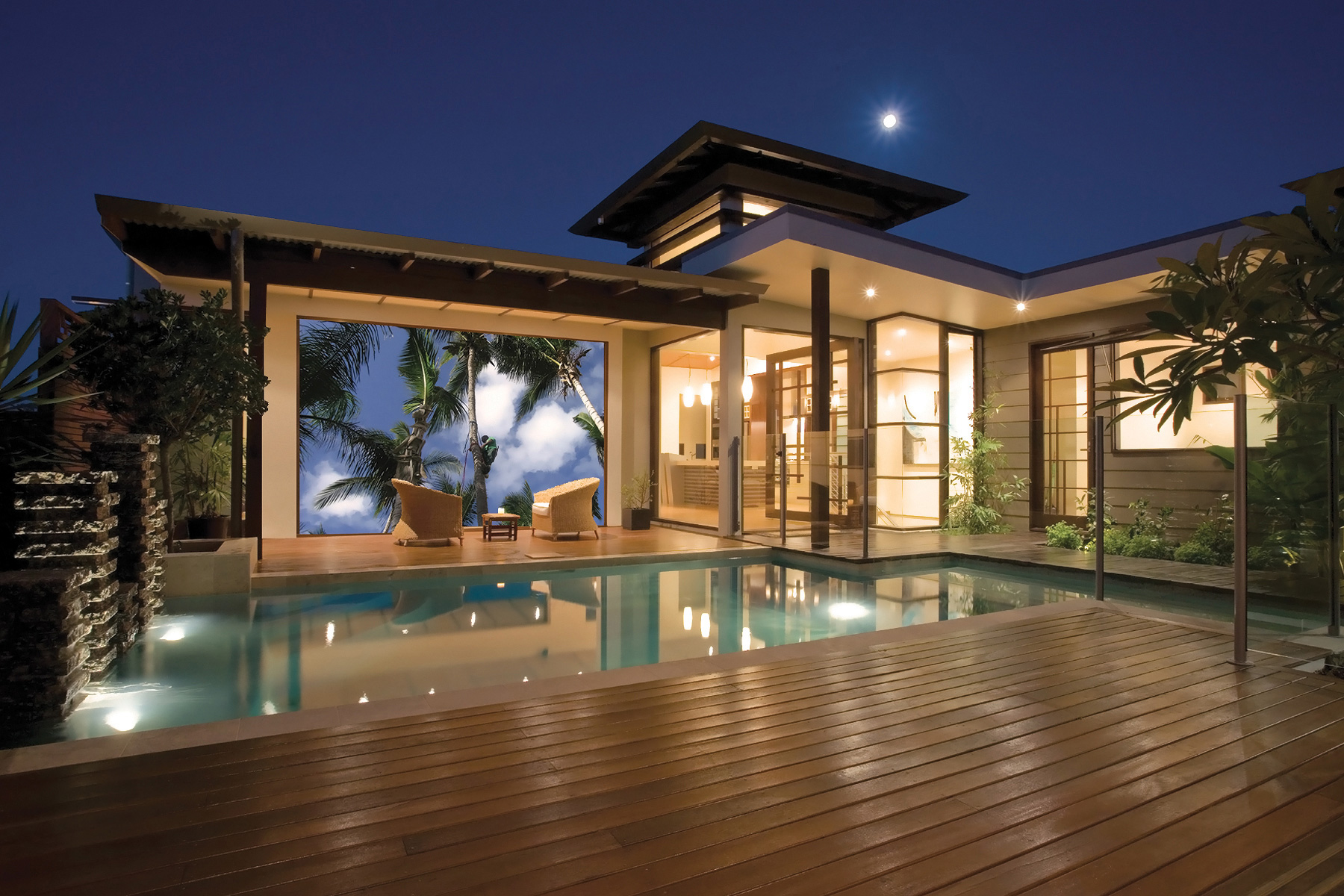
The Changing Shape of Cinema: The History of Aspect Ratio.
Stewart Filmscreen’s Transformer. Blinds, Masking and Power Screen all together.
The latest screen materials available.
A new and beautiful way to hide large screens.
Stewart Filmscreen Starglas is a unique rear projection product, imagine the possibilities!

